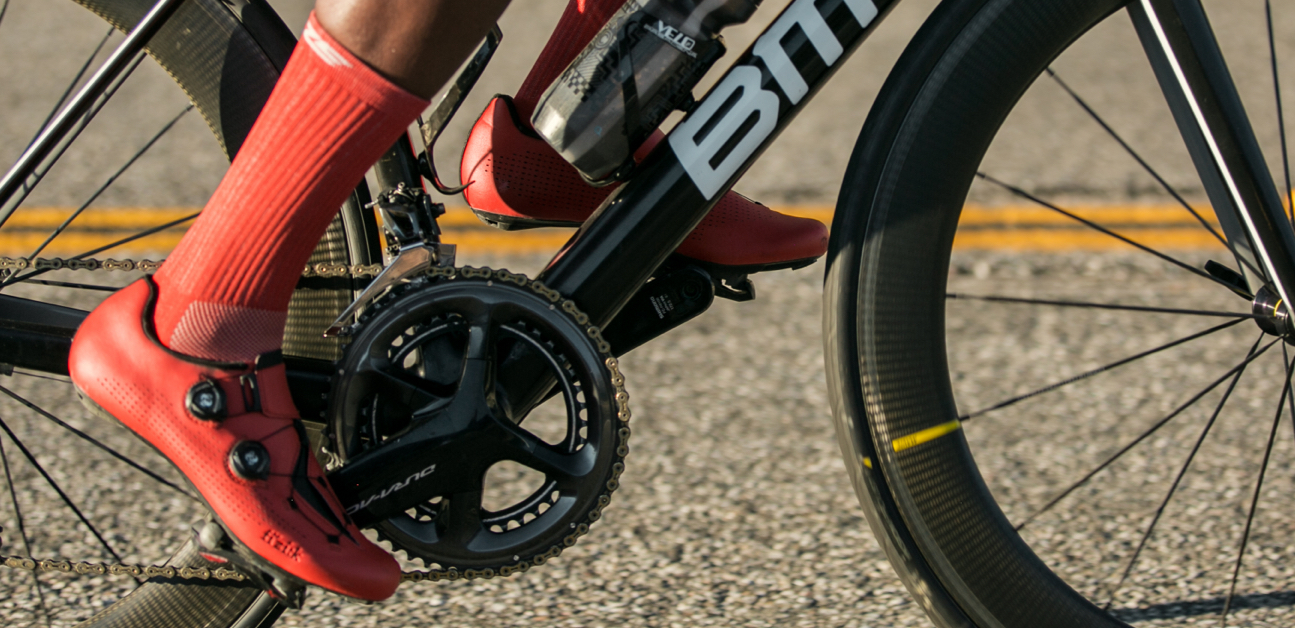Crank Length: What Length Cranks Should I run?

Running a longer crank might seem like it will increase power, but for most cycling disciplines, the research suggests otherwise. Here’s why you should opt on the shorter side and prioritize comfort over leverage when choosing a crankset.
For more training and cycling related deep dives check out the Ask a Cycling Coach Podcast Episode 287.
Finding the Right Crank Length
Variations between crank lengths are quite small, but the difference between the wrong and the right length can be big. This is because your crank length plays an intrinsic role in your bike fit.
When you change the length of your crank, it raises or lowers the position of your foot. When your foot’s position changes, your saddle needs to be raised or lowered the same amount. Adjusting your saddle height alters your body position in relation to your frame, and depending on the adjustment made, will open or close your hip angle. When done correctly, changing crank lengths can impact comfort, aerodynamics, clearance, and performance.
Common Crank Lengths
Most cranksets are available in 160 mm, 165 mm, 170 mm, and 175 mm options. Though, 167.5mm, 172.5 mm, 177.5mm, and 180mm lengths are also available for certain cranksets. Because the crank length is a part of your bike fit, the best length depends on your height, body proportions, and joints.
Adaptive Training
Get the right workout, every time with training that adapts to you.
Check Out TrainerRoadWith that being said, there’s some flexibility when it comes to choosing a length. In fact, you may find that you can swap between two different lengths without any issues or even without noticing a difference. This might make you wonder, if I have the flexibility to swap between two different crank lengths, should I opt for the shorter crank length or a longer one? Is there an advantage to going with either one?
Power vs. Comfort
If you’re considering two different lengths you might be tempted to choose the longer of the two. This is likely because longer cranks offer more leverage which leads many athletes to believe that these cranks create more opportunity for power. While a longer crank does have more leverage, the research on the relationship between crank length and power maximization suggests that running a longer crank arm only offers a maximal power advantage at extreme lengths.
Crank Length for Power
In studies on crank length and power, referenced below, athletes only saw an increase in their maximal power, in proportion to crank length, when they went to the extremes. In the first study referenced, there was only a 2-5% decrease in power between crank lengths when athletes used the shortest 120mm crank and the longest, 225mm. In another study on the optimal crank length to leg length ratio, athletes only saw a 4% decline in power between the 120mm and 220mm lengths. Most athletes from this study also found that the 170mm crank length was the sweet spot regardless of the athlete’s inseam measurement. The accumulation of this research and a few additional studies suggest that crank length optimization is irrelevant to power, speed, and efficiency.
Crank Length Resources and Studies
- The effect of bicycle crank-length variation upon power performance
- Effect of Crank Length on Joint-Specific Power
- The Effects of Bicycle Crank Arm Length on Oxygen Consumption
- Determinants of Maximal Cycling Power: Crank Length Pedaling Rate and Pedal Speed
- Acute effects of small changes in crank length on gross efficiency and pedaling technique during submaximal cycling
- How Crank Length can Improve YOUR performance
Crank Length for Comfort
So if the discrepancy in power output between the extremes is fairly small, what should the deciding factor be when choosing between crank lengths? The short answer is comfort because it has a direct correlation with performance. Crank length can enhance your comfort and as a result increase your performance.
While you might be able to swap crank lengths without any issues, for some, opting for a longer length can cause discomfort on the bike with increased rocking in the saddle and added pressure on certain joints. Choosing a shorter option can increase comfort and improve long term joint health.
Advantages to Shorter Crank Lengths
There are also numerous advantages to running a shorter crank length. A shorter length improves aerodynamics by widening the hip angle and dropping your front end closer to the front of the bike. In a bike fit adjustment with Bradley Wiggins, Wiggins dropped from a 177.5mm crank arm to a 170mm crank arm, which dropped his front end by 30 millimeters. As a result, he accumulated a 3.5% improvement in aerodynamics.
There’s also a technical advantage to using shorter cranks as they offer more pedal clearance. In particular, if you’re an off-road athlete, running a shorter crank length will give you more clearance pedaling up technical sections of trail and an increased response time during races. Even cyclocross and criterium racers may be less likely to clip a pedal with a shorter crank length.
Moving Forward
While it’s logical to consider your crank length’s effect on power maximization, it doesn’t have enough impact on power for that to be a deciding factor in your decision. It’s much more impactful to prioritize comfort by choosing a crank length that puts you in a comfortable position on the bike.
With all that being said, if you’re experiencing any type of pain due to your bike fit, or crank length, you’ll most likely want to work with a physical therapist or professional bike fitter to choose the best crank length for you. You can read more on bike fit here: A Conversation About Bike Fit With Dr. Andy Pruit
For more cycling training knowledge, listen to Ask a Cycling Coach — the only podcast dedicated to making you a faster cyclist. New episodes are released weekly.